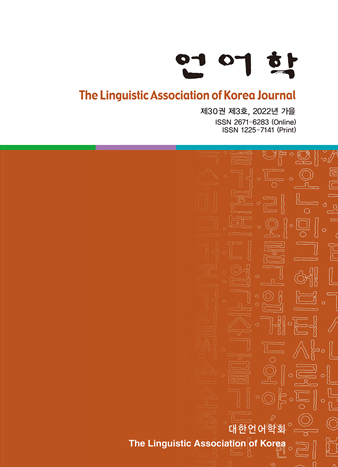대한언어학회 전자저널

30권 3호 (2022년 9월)
- Extraposition of that-Complement Clause
-
Seung Han Lee
Pages : 43-61
Abstract
Lee, Seung Han. (2022). Extraposition of that-complement clause. The Linguistic Association of Korea Journal, 30(3), 43-61. This study aims to provide the grammatical and discourse properties of that-complement clause extraposition (hereafter CCE) constructions with the help of a total of 3,791 sentences from COCA. As a starting point, we lend weight to the argument that the extraposed clause of the head noun appears to be more akin to appositive than relative clause constructions. In corpus findings, the singular form as well as the definite article are clearly more frequent with respect to use of the head noun characterized with [ANIMATE -] and [THEME +] values. As well, the present tense predominantly comes into use, whereas the presentational verbs take the extraposed that-complement clause fairly often. Of particular relevance here is that we provide several types of modality of the head noun, so the epistemic value making up most of the occurrences is further classified into five groups: evaluation, argument, evidence, idea, and perception. The final question addressed in our investigation is what illocutionary force a speaker or writer conveys within the that-complement clause. Self-assertion shows the highest rise in the use of illocutionary force, while prior context is highly favored over no discourse-based information in CCE construction.
Keywords
# that-complement clause # CCE # head noun # modality # illocutionary force
References
- Aldwayan, S. N. (2012). The syntax of relative and appositive clauses. Journal of King Saud University-Languages and Translation, 24(2), 95-100.
- Ballier, N. (2004). Deverbal nouns as heads of noun complement clauses in English. In J. J. Lecercle (Ed.), Dossier en Vue de l’Habilitation à Diriger des Recherches (pp. 4-35). Unpublished Habilitation thesis, Université de Paris X.
- Biber, D., Johansson, S., Leech, G., Conrad, S., & Finegan, E. (1999). Longman grammar of spoken and written English. Harlow, UK: Pearson Education.
- Biber, D. (2006). University language: A corpus-based study of spoken and written registers. Amsterdam: John Benjamins Publishing Company.
- Charles, M. (2007). Argument or evidence? Disciplinary variation in the use of the noun that pattern in stance construction. English for Specific Purposes, 26(2), 203-218.
- De Haan, P. (1989). Postmodifying clauses in the English noun phrase: A corpus-based study. Amsterdam: Rodopi.
- Grimshaw, J. (1990). Argument structure. Cambridge, Mass.: MIT Press.
- Hidarto, A., & Andrianto, S. (2015). The omissibility of that in noun complement clauses: Corpus evidence. Paper presented at the 3rd Atma Jaya Conference on Corpus Studies, Jakata, Atma Jaya Chatholic University of Indonesia.
- Huddleston, R., & Pullum, G. K. (2002). The Cambridge grammar of the English language. Cambridge: Cambridge University Press.
- Kanté, I. (2010). Mood and modality in finite noun complement clauses: A French-English contrastive study. International Journal of Corpus Linguistics, 15(2), 267-290.
- Kayne, R. S. (2008). Why isn't this a complementizer? In P. Svenonius (Ed.), Functional structure from Top to Toe: A Festschrift for Tarald Taraldsen (pp. 188-231). New York: Oxford University Press.
- Kayne, R. S. (2010). Comparisons and contrasts. New York: Oxford University Press. Keizer, E. (2005). The discourse function of close appositions. Neophilologus, 89(3), 447-467.
- Kim, J.-B., & Sells, P. (2008). English syntax: An introduction. Stanford, CA: CSLI publications.
- Krapova, I., & Cinque, G. (2016). On noun clausal “complements” and their non-unitary nature. Annali di CaFoscari, 50, 77-107.
- Lee, S.-H. (2018). English sentential subject extraposition: A constraint-based approach. The Linguistic Association of Korea Journal, 26(3), 71-87.
- Mikkelsen, L. (2014). Clausal complements to N in Danish. Paper presented at Workshop on the North Germanic Noun Phrase, Universitet i Tromsø.
- Moulton, K. (2009). Natural selection and the syntax of clausal complementation. Unpublished doctoral dissertation, University of Massachusetts Amherst.
- Nomura, M. (1993). The semantics of the content clause construction in English. English Linguistics, 10, 184-210.
- Palmer, F. R. (1986). Mood and modality. Cambridge: Cambridge University Press. Quirk, R., Greenbaum, S., Leech, G., & Svartvik, J. (1985). A comprehensive grammar of the English language. London: Longman.
- Schmid, H. J. (2012). English abstract nouns as conceptual shells. Berlin: Mouton de Gruyter.
- Stowell, T. A. (1981). Origins of phrase structure. Unpublished doctoral dissertation, Massachusetts Institute of Technology.
- Zeleňáková, M. (2016). Noun that-complement clauses and the expression of stance in the English-French bilingual corpus of the Acq uis Communautaire. Legalese as an “objective” genre. SKASE Journal of Theoretical Linguistics, 13(1), 1-22.